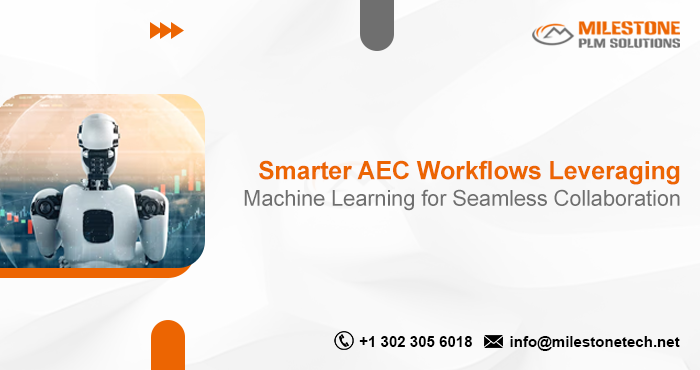Smarter AEC Workflows: Leveraging Machine Learning for Seamless Collaboration
- Milestone PLM Solutions
- Jun 16
- 3 min read
In today's fast-evolving Architecture, Engineering, and Construction (AEC) industry, the need for faster, smarter, and more coordinated workflows has never been greater. As projects grow in complexity, traditional collaboration models are often unable to keep pace. Enter Machine Learning (ML) — a powerful subset of artificial intelligence that is transforming AEC workflows by enhancing decision-making, predicting outcomes, and enabling seamless collaboration among stakeholders.

The Growing Complexity of AEC Projects
Modern AEC projects involve multiple disciplines, vast amounts of data, and geographically dispersed teams. Coordinating these elements requires more than just human effort — it demands smart technologies that can streamline communication, reduce errors, and enable real-time decision-making. That's where Machine Learning in AEC steps in.
ML algorithms excel at identifying patterns, learning from historical data, and optimizing processes without explicit programming. When integrated into AEC workflows, they allow teams to work more efficiently, make data-backed decisions, and avoid costly delays.
Real-Time Collaboration with Data-Driven Insights
Machine learning enables real-time collaboration by providing project teams with predictive insights based on historical and real-time data. For instance, ML models can forecast construction delays by analyzing weather reports, supply chain status, or labor availability. This foresight allows stakeholders to adjust timelines proactively and allocate resources effectively.
Additionally, machine learning tools integrated into Building Information Modeling (BIM) platforms allow architects, engineers, and contractors to collaborate on a shared digital twin of the project. These tools can automatically detect design clashes, suggest corrections, and update all versions of the model instantly — significantly reducing coordination time and errors.
Intelligent Automation of Repetitive Tasks
One of the most immediate benefits of machine learning in AEC workflows is the automation of repetitive, time-consuming tasks. Tasks such as site inspections, quantity takeoffs, and document control can be streamlined through ML-powered systems.
For example:
Computer vision algorithms can analyze images from drones or site cameras to detect construction progress or quality issues.
Natural language processing (NLP) can automatically extract information from project documents, flag inconsistencies, and categorize communications.
ML-based scheduling tools can adjust timelines in real time based on changing field conditions or resource availability.
This intelligent automation frees up human experts to focus on more strategic, high-value activities like design optimization, stakeholder management, and innovation.
Enhancing Communication Across Teams
One of the biggest challenges in AEC collaboration is ensuring clear communication across teams with different expertise, tools, and terminologies. ML-driven communication platforms are helping bridge this gap by:
Translating technical data into actionable insights for non-technical stakeholders.
Summarizing meeting notes and tasks automatically.
Predicting and resolving communication bottlenecks before they escalate into conflicts.
Such capabilities reduce misunderstandings, improve transparency, and foster a culture of collaboration, especially in remote or hybrid project environments.
Machine Learning in BIM and Digital Twins
The integration of machine learning into BIM and digital twin technology is revolutionizing the way buildings are designed, constructed, and maintained. ML algorithms can analyze historical BIM data to suggest optimal design solutions, simulate various "what-if" scenarios, and even predict building performance over time.
Digital twins enriched with ML capabilities allow real-time monitoring and predictive maintenance throughout the building lifecycle. This means architects and engineers are no longer just designing structures — they are creating intelligent systems that continue to evolve and improve even after construction is complete.
Risk Mitigation and Quality Control
Quality and safety are paramount in any AEC project. Machine learning enhances both by predicting risks and monitoring quality in real time. ML algorithms can detect anomalies in construction patterns, flag potential compliance issues, and suggest proactive measures to avoid failures.
Predictive models also analyze data from past projects to identify risks such as budget overruns, design errors, or schedule delays. Armed with these insights, project managers can mitigate risks before they affect project outcomes, ensuring smoother workflows and better overall performance.
Future-Proofing AEC Collaboration
As machine learning tools become more advanced and accessible, their impact on AEC workflows will continue to grow. Companies investing in ML-powered platforms now are not only improving current project performance but also setting themselves up for long-term success in an increasingly digital industry.
Future trends include:
AI copilots embedded in design software to assist with drafting and code compliance.
Adaptive learning systems that get smarter with every project.
Hyper-personalized dashboards for each stakeholder based on their role, tasks, and priorities.
Conclusion
Machine Learning in AEC is not just a technological trend — it's a transformative force enabling smarter workflows and seamless collaboration. By automating routine tasks, providing real-time insights, enhancing communication, and mitigating risk, ML empowers teams to deliver better outcomes faster and more efficiently.
For AEC firms striving to stay competitive and future-ready, embracing machine learning is no longer optional — it’s a strategic necessity. The smart integration of ML into design, planning, and construction workflows is not only improving how we build but also how we work together.

